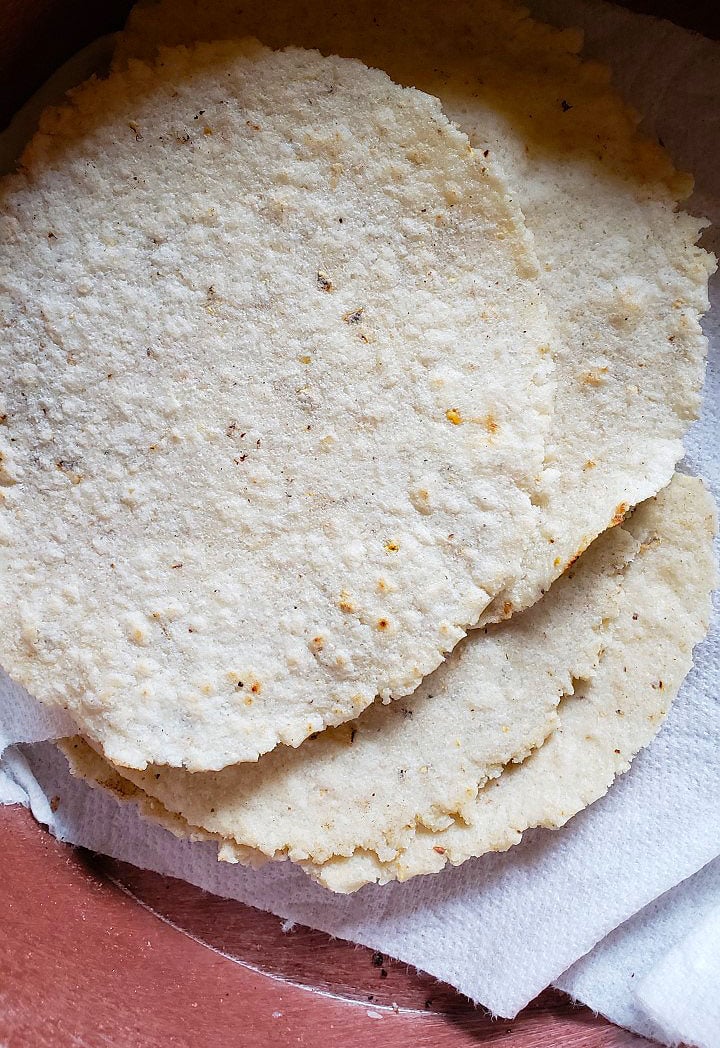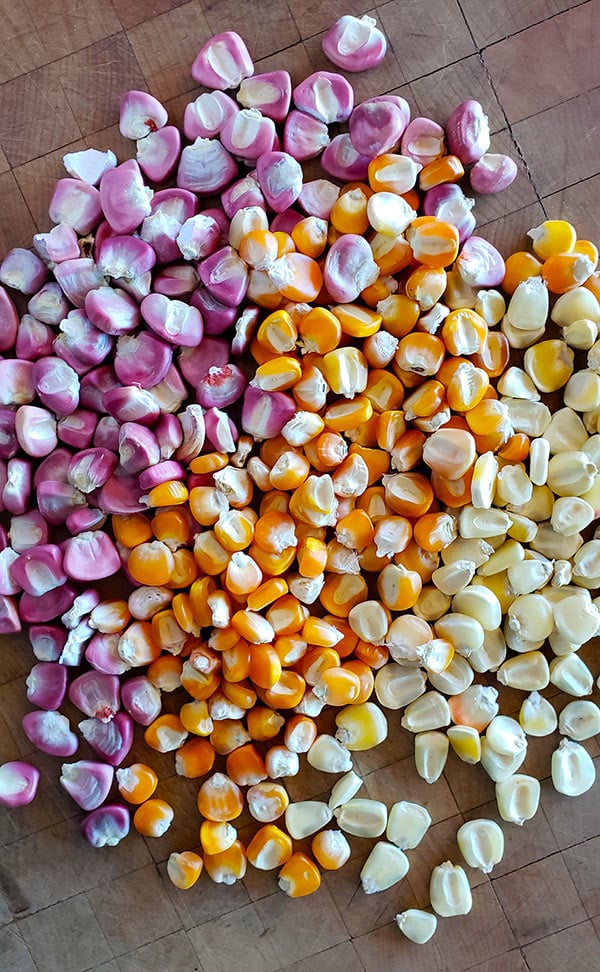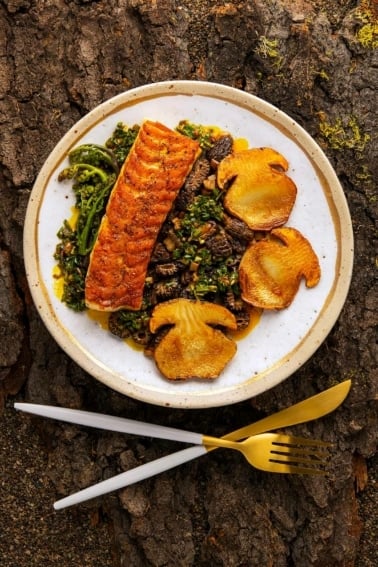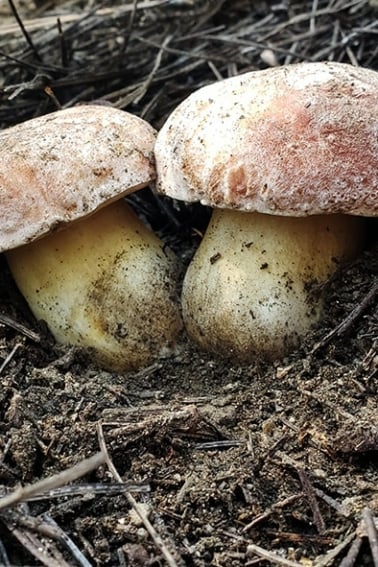As an Amazon Associate I earn from qualifying purchases.

These are my tortillas. They are made from Mexican heirloom corn I nixtamalized myself, ground twice, then formed and griddled on an iron comal. I am not proud of them. But I am getting better.
I know, they look pretty nice. But these tortillas are too thick, and were slightly brittle. They did not break in half, but they were not nearly so flexible as they should be. I suspected my masa was too dry, not quite cooked enough, and that my comal was too cool, facts confirmed by my friend Patricio Wise, a chef from Nuevo Leon, Mexico.
At least they tasted good.
I’ve been making a lot of tortillas lately. There is a reason for this that goes beyond whipping up a batch of tacos.
A great many good things in this life hinge on the perfect execution of something that is simple, but not easy. Writing a good sentence. Shooting a rifle. Casting a line. Driving to work. Being on time.
In food, show me a cuisine and I will show you that hinge. If you walk into a French restaurant and want a job, many chefs will ask you to make an omelet. Go to the Italian place, and chef will likely ask you to make pasta. Cajun joint? How good do you do roux, breaux?
In Mexico, it is the tortilla. These disks of either corn or flour are literally the foundation of that cuisine. But unlike sex, bad tortillas are just bad. And I have eaten a great many bad tortillas.
Flabby, factory-made tortillas that stink of industrial cleaners. Sour tortillas sweating in plastic bags for who-knows-how-long. Flour tortillas that were really Italian piadine flatbreads and yes there is a difference. Well-meaning home cooks making flour “tortillas” puffier than pita. Sad tortillas kluged together from cheap masa harina, which is to real masa what Golden Corral is to the French Laundry.
And don’t get me started on those pre-bent, hard-shelled Ortega monstrosities. Who thought that having your edible wrapper shatter at the first bite was fun?
Despite all this, I’ve had quite a few good tortillas, too. But I’ve had precious few great tortillas. One that lingers is a flour tortilla made by Tortillas Mi Pueblito in Mammoth, Arizona. Another is a corn tortilla handmade by Patricio.

To me, a great tortilla is not only mechanically perfect — thin and flexible — but it also has levels of flavor so rich that they are delicious unadorned. The experience starts before you even get the tortilla to your lips. They are round but not perfect. They are freckled with char. And the aroma of good wheat or good corn grabs you and holds on.
That aroma leads to flavor. Good corn, especially, satisfies every bit as much as good wheat: Better even, when you consider that a wheat tortilla requires lard, and lots of it. Corn tortillas are just corn, water and maybe salt.
Most people never bother with homemade tortillas. Most people buy them with no more thought than which brand they prefer, if that. Don’t get me wrong, I buy tortillas, too, for the same reason everyone else does: expediency.
But at least for me, to understand Mexican cooking, really understand it, I must be able to make a good tortilla.
It’s part of the whole stand-before-you-walk, walk-before-you-run philosophy I have always tried to follow. Jackson Pollock did not start his art career splashing paint on a giant canvas. Almost every day I wake up hot with ideas about how I can experiment with this ingredient or that cuisine, but always I hear my inner voice scolding me for cherry picking.
Sure, I can make a pretty good pipian or tamal, and even a decent mole.
But if I were to walk up to the great Mexico City chef Enrique Olvera and ask to work at his restaurant Pujol, chances are he’d ask me to make a tortilla. And even if he didn’t, I’d be mortified if I could not do so among such great Mexican chefs.
It took me years to become an accomplished pasta cook. I am good enough at it now that I would not fear to make cavatelli or gnocchi or tajarin for an Italian chef. I don’t know how long it will take me to become a competent tortillero. But I am working on it.
As usual, it’s the little things, things that are not in any recipe I have read in either English or Spanish. Even armed with a good recipe, I have not yet made a flour tortilla half as good as I’d like. Some taste like bread. Some were too thick. Others ballooned rather than bubbled, making a few large char spots, not lots of little ones.
Too much lard? Not enough? Comal too hot? Was the dough rested too much or too little? Hell, even rolling out tortillas is a skill.
Easier with corn tortillas, but when I make them super thin they break as I try to peel them off the pieces of plastic I use to prevent the masa from sticking to my tortilla press. Maybe use thinner plastic, like a grocery bag instead of a heavy freezer bag? So many little details…
If you think about it, the singular act of making a memorable tortilla is a skill valued for millennia in Mexico. A skill, in the past, used to gauge a woman’s value as a wife, and even today a cook’s value in the kitchen regardless of gender.
Given this, it would be downright insulting for me, or anyone jumping into this, to think we could nail it in the first, tenth or even hundreth time. I am so good at cooking duck breasts and filleting fish because I have done these tasks literally thousands of times. So it will be with making tortillas from scratch.
More failures lie ahead. And that’s OK. It’s worth it.





Bravo. This article and comments are really informative. I’ve made tortillas from masa made by a local tortillaria for some years, with varying success. Now I’m excited to take the next step into nixtamalizing and grinding my own corn. FWIW my tortilla press is a hand made wooden one made from 2 x 12’s, and has a lot of leverage. Looking forward to your definitive article and recipe on the subject.
I’ve been thinking about this since you first posted it, and type this as I eat barbacoa and eggs on homemade tortillas, open faced. I too have tried to make my own, and while edible, not anywhere close to the perfection I’ve had when eating a very well crafted hand made tortilla. The flexibility issue is confounding. Right now I’m just using store bought masa but am inspired by your post to try making my own as I already grow my own flour corns. I have a couple of thoughts.
Cooks Illustrated has a recipe for 100% corn cornbread. Part of the trick to it is to mix part of the cornmeal with very hot water to hydrate/gelantinize the starch in the corn. THEN the rest of the ingredients are added to make the batter. This creates a cornbread that isn’t excessively crumbly. Carol Deppe has a similar recipe in her “Resilient Gardener” book. I suspect that corn tortillas have a similar “magic” temperature for the hot water. Instructions say “mix with hot water”. How hot? How much? How long to you let it sit after mixing? At room temp or refrigerated? Would a mix of corn flour mixed with hot water and then more flour added give a better result then adding all the flour all at once? How critical is the temp of the pan (ie will 45 seconds per side on a screaming hot pan give the same results as 90 seconds on a not quite as hot pan)? It’s really hard to get a home stove pan screaming hot, while in Mexico, videos often show the griddle over open flame or very hot coals.
So I’m starting to play around with measuring by weight for consistency and trying different temperatures. Will see if I have any breakthroughs. I know in Mexico, they often have their masa ground at the local tienda, and that appears to be at room temperature, but there is probably some heating during the grinding, just from friction. SO many variables.
I’ve been making corn tortillas with organic blue corn masa and yes it isn’t as easy as it may seem. Thinking of using only cornmeal without lime and adding my own nixtamal made from Juniper ashes. According to “Navajo Corn Recipes: Diné Binaad????’ Ch’iyáán” (available on Amazon) Juniper ashes not only work and taste better but have higher mineral content than lime or baking soda.
Great essay. I probably enjoy these more than the recipes.
My only regret of this article is that there is no recipe or process from which to begin our trials.
I owned a Texas cafe in the 90’s where we were touted as having the best Chicken fried steak in the state according the Texas Highways magazine. Our cook had been there long before I came along and she was not about to tell anyone how she did it. One of my employees was from Central America and made tortillas from scratch which were as you described and her Tamale at Christmas was something to behold, and savor every fleeting bite. Sadly I didn’t have the foresight to learn how to make them myself and now I suffer for it.
Paul: There are lots of tutorials on the internet for now. Once I get a handle on things, I will post mine.
Hi Hank,
When the tortillas are brittle and break, I found that adding calcium to the masa helps.
Partly use mineral water instead of tap.
For me, this reflects the water in the city in Mexico where we lived that had water with extreme mineral content.
Best Chris
A lot of emphasis on perfection in this post. Just enjoy the process. Try growing some different kinds of corn yourself (it’s fun!). Try using wood ash instead of Calcium Hydroxide for the nixt process. Many North, Central and South American cultures enjoy tortillas that AREN’T thin. Tortillas by nature have a bit of a rustic quality to them. Perfect tortillas?
So many,many things are like that in the kitchen…I agree with you completely. Really enjoy your posts.
Hank, I’m happy to know that I’m not alone on my quest. I attempted my first homemade flour tortillas one cold, rainy day, simply because I did not want to brave the elements to go out and buy them. Admittedly, they were a dismal failure but, of course, I learned a LOT from the experience. Frankly, I was just grateful that no one else happened to be home at the time to view or taste the carnage! Next time was much better, but I’m a long way from “nailing” it. This is just one of those things that unless you learned it at your mother’s knee, it’s gonna take a lot of experimenting, practice and tweaking. But really, isn’t that how knowledge and expertise of any value is obtained? In the end, it’s a labor of love and discovery. Thank goodness, until I master it, there are excellent flour & corn tortillas for sale in abundance all over my beautiful, heavily Hispanic city of Oakland, CA. In the meantime, I’ll keep trying to perfect my own. One day I’m gonna nail it!
Wow. Nixtamalizing it yourself?! That is some dedication! I love it. Tortillas are perfect, aren’t they?
I’m so impressed.
Hi Hank,
My girl friend forwarded this article to me. Several years ago we were in the hills of Honduras on a tour. At one stop, I ground some corn for tortillas and my girl friend helped the lady of the house slap together the mixture into tortillas. Girl friend was told that she’d never get a man with those tortillas. LOL
Forward to now. I make corn tortillas with my homemade press. I use masa harina but had some frustration with thickness and cracking. Here are the solutions that I found. First, let’s talk about getting the tortillas off the press. I started with parchment paper which needed to be replaced frequently and then tried plastic grocery bags suggested by Pati Jinich from Pati’s Mexican Table (too flimsy). I ended up using thick plastic sheets that my fish monger uses before wrapping fish in paper. Works great. Press, remove top sheet from tortilla (placing sheet on other side of the press), flip the tortilla over and peel the second plastic sheet from tortilla.
To deal with the thickness of the tortilla and cracking, I tried adding some flour the masa harina (4:1 masa harina/flour). Worked great. I mentioned this to the owner of a local Latino grocery store/restaurant. She said that her staff adds a little flour to their corn tortillas along with a little oil. I reduced the amount of flour and added a little olive oil. That worked great, too. (I don’t have exact measurements, just play around.) Very nice thin tortillas that don’t crack.
BTW, I basically use your recipe for smoked salmon on my Big Green Egg. Wonderful!
BTW, I
I am currently in the midst of the same struggle, Hank. Add in using locally grown corn of different sources. Hang in there Brother!
hi! i enjoy your newsletters very much! from where do you get your corn?
Liz: The best stuff I get is from a company called Masienda. They do mail order.
Been working on this off and on for a long time. Still can’t get it right…. Thanks for the tips and thoughts though, I’ll keep trying.
Hank,
This is woman’s work in Mexico. Men do not have the patience to make and master the technique required for dozens of corn tortillas from scratch each day. These days most women in Mexico do not do this anymore either. And the ones who do make their own tortillas at home fresh each day rely on a commercial or village molineria to grind their corn masa to their own desired consistency. For tortillas it is very fine. As you know options for home grinding of wet nixtamilized corn is pretty limited in the US as a meat grinder does not produce the right consistency no matter how many times you pass the masa through it. The hand cranked Corona wet mill works but production is really slow by hand…
About that heirloom corn, blue and red Indian corn makes a difficult and rapidly souring masa that does not keep and gives the commercial operations fits. Could be the high lysine content. It is important to find a flint corn you like for nixtamilization and stick with it. Don’t switch it up as you need to get proficient for your own process and judging how long to cook it and soak it for your style of masa is really important to the success of the final product. The speed of pericarp softening will vary for the variety of corn and where it was grown.
From the looks of your pictures the masa was too dry and too crumbly to make an even tortilla as the surface is very pebbly and uneven. Maybe a longer soak after boiling. Your grind needs to be finer, so try adding more water after grinding and maybe you need a much bigger and heavier press. The ones in Mexico City are made from plate steel and have a relly long steel handle to press things hard and fast. The tiny home zinc die cast presses require a really wet masa to work well as the amount of leverege is low on the small handled home press. Patting out round tortillas by hand is really the toughest road to follow. There are a bunch of Indian subcontinent gluten free grain flatbreads made from Sorghum and various millets that are also ground and flattened out by hand and various YouTube videos give some good pointers on how to deal with such wet and sticky doughs and the details of shaping them by hand. Just watching a Mexican woman patting out fresh tortillas at lightspeed really doesn’t help with your own technique as she makes it looks easy. She has been doing this since she was a little girl helping her mom every day in the kitchen. For some reason the Indian flatbreads from gluten free grains are done slower and you can watch how they moisten their hands and the surface of the sticky dough to get it into final shape before the comal dries it out and firms it up.
A big problem in the US is that most latino communities have developed a taste for tortillas made from masa seca, the masa harina or dried corn flour like the Maseca branded product sold in grocery stores nationwide. This stuff is taking over Mexico too. Tortilla factories buy the stuff by the ton and it keeps. That means your store bought “fresh corn tortillas” were made from a dehydrated corn flour that is added to water to rehydrate and then fed through high speed automated corn tortilla machinery to make a machine made product. Added ingredients can include guar gum and other thickeners to help the product move along and not stick to the machine. This has nothing to do with taste or texture compared to a fresh hand made tortilla made from heirloom corn. But many latinos in the US now prefer this style of tortilla as the homemade one does not exist anymore. That means that many bags of masa preparada sold in Latino Mercados are also made from the dried Maseca and are no longer made from freshly made nixtamalized corn.
I have found the most non-stick plastic for my tortilla making to be the translucent plastic film bags used for ready to eat cereals like Cheerios and Corn Flakes. I save them and open them up along the seams. Cling warp is worthless! I also wipe a thin coating of Crisco (Hank, use your bear grease from the larder) on one side before making a couple of dozen tortillas. Ziploc PE bags are terrible compared to this stuff.
BTW, Many authentic fresh tortillas puff up into a giant balloon on the hot comal before they are finished cooking. I see that on videos from Oaxaca, Quintana Roo and other areas with tons of Mayan folks who still do things the same way as their ancestors.
As for flour tortillas from wheat flour, get yourself a bag of Blue Bird Flour from Cortez Milling, as it’s all grown and milled in the Four Corners area and see what a difference a Sonoran wheat flour makes in your flatbreads.
What a wonderful read. I too, though not a chef, hold the tortilla in high regard. Those made by my wife’s 90+ year old grandmother are so good they almost defy logic. Thin, delicate, strong and pliable. We need to pay her a visit…
Your timing of this is perfect. I’ve been wanting to make tortillas for a while and decided that this month was the month to take the plunge. Thank you in advance for helping me not get discouraged!